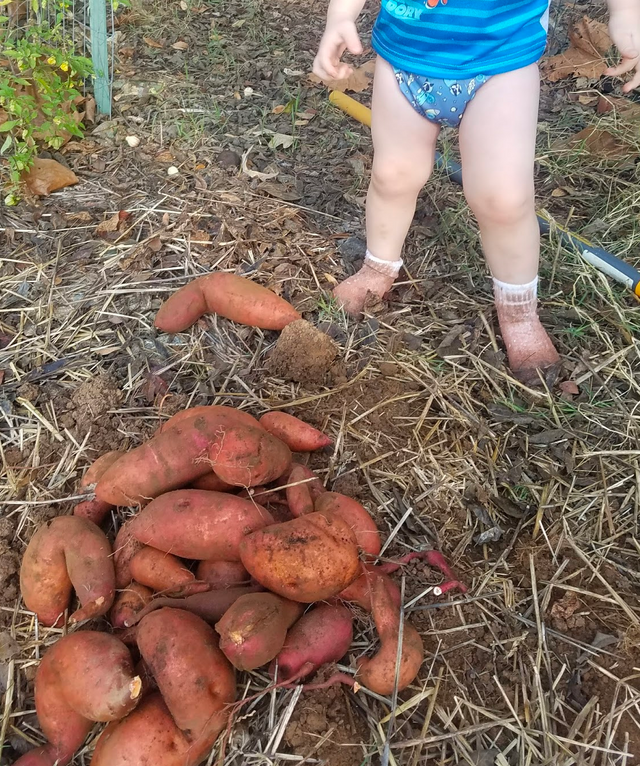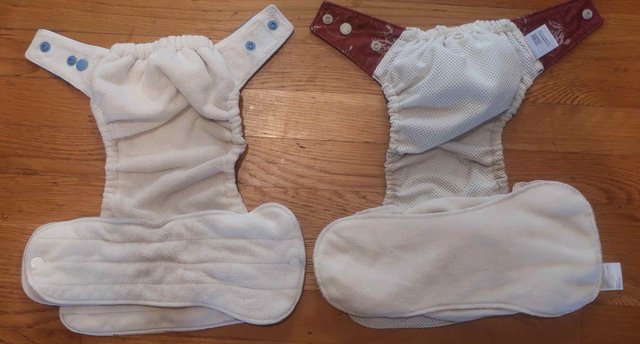How to cloth diaper: straight talk from experienced parents
Warning: this post contains gritty truth about how to successful cloth diaper. It is not for the nervous, prospective parent or the feint of heart.
There are many reasons to consider cloth diapering. How to actually cloth diaper is actually quite easy but there is a lot of false information floating around the makes it seem like a mystical process for learned and initiated. Here is our experienced over 1000’s of diapers. I have included all information we could remember but this isn't hard.

one of the brood rocking a dog-in-space Grovia, may need those socks to be laundered after digging up sweet potatoes
Starting cloth diapering: Counterintuitive advice
Early mistakes
Here is how new parents drop out of cloth diapers. They get some cloth diapers during a baby shower, and they buy some more. They pick out cute colors and read about it online. And then they have their first baby, and their world is turned upside down. In those first few months, they don’t have time to eat, they don’t have time to work, and they don’t time to sleep. And they sure don’t have time to launder diapers every day. But these new parents try anyway. They find the baby frequently leaks with the cloth diapers and they don’t fit right. So they quit in 2 weeks and the cloth diapers sit on a shelf until they try to give them to someone like me.
Solution: use disposable diapers for the first 3 months post-partum
Cloth diapers are less effective for newborns because of their size, particularly lack of mass on the baby’s thighs. I tell my friends, just use disposable diapers for the first few months. Use that time to test drive the cloth diapers and decide on a plan.
Selecting cloth diapers
Use the first few months to decide with style and brand of diapers you want.
The number of options in the cloth diaper have exploded in the last decade, and new parents are likely to be suffering from the paradox of choice.
Some broad options include:
Traditional diapers: a muslin cloth that is pinned around the baby.
Pros: Easy to launder, inexpensive, and widely available
Cons: Require frequent changing, and, sadly, in the West we have lost this skill, so they are “Grandparent proof”All-in-one system: A diaper shell with inserts that slide in a pocket or clip in.
Pros Low learning curve, less frequent changing
Cons Higher cost, not widely available in many parts of the worldHybrid system: An exterior shell with removable pads that allow you to often use one shell for multiple changing
Pro Low learning curve, less frequent changing, lower cost since buying fewer shells, more breathable in summer
Cons Still more expensive per unit than traditional diapers
I would recommend buying a couple of each option and just trying them in the 2-3 month range. We use hybrids for the day and all-in-one systems at night. After trying many brands, we use the GroVia hybrids for daytime use and the O.N.E. model for naps. At 3 months (or when a child starts size 2 disposable), we transition to full-time cloth diapers (except for overnight).

O.N.E. system on the left, Hybrid on the right
Washing cloth diapers
Controversial advice
Don’t necessarily listen to the manufacturer’s advice about laundering
We did and it led to prolonged illness of our first born. Many manufacturers call for using special gentle detergents and avoiding deep cleansers like borax. We made our own gentle detergent for the first year to comply with this recommendation. Our son developed a bad diaper rash that would not heal. To make a long story short, we—naive new parents—trusted a medical provider’s advice we shouldn’t have and our son experienced a drug allergy which led to the early stages of Stevens-John Syndrome (I didn’t include a link because it is too horrifying). Quick thinking by a pediatric intensivist turned it around in a matter of hours but he was left with hives all over his body for months. This is an extreme example, but consider the risk benefit profile of gentle vs. deep cleaning.
Benefits
Less diaper rash, less chance of recurrent stomach flu infection, and cheaper
Risks
Supposedly more wear to the diapers meaning you may have to replace them sooner. We have been continuously laundering our GroVia for 3 years with the following regimen and have replaced ZERO diapers so I am skeptical of this claim.
Laundering process
Throw in 10-15 diapers in the laundry. I knock off the poop but don’t go crazy trying to get it off.
Use half of the recommended amount of standard Tide (or as we use, the Aldi knock-off brand)
Shake like 1/4 to 1/2 cup Borax in
Fill up the washer with water (on the highest load amount you can) and stop the cycle. Let is soak anywhere from 30 minutes to overnight (we never find overnight necessary since we started using conventional detergent).
Run it and select the rinse twice option
We use a top-loading agitator washer. I can’t speak for the efficacy of the HE front-loading washer but we find the agitator very effective. We also run on well water so it costs a negligible amount to increase the washing volume.
Last, once a month, wash all the pads with 1/4 cup bleach
Drying
- Summer: hang shells and pads on line. I find the heat and the sun very effective at whitening and freshening them.
- Winter: hang shells on drying rack near heat source, flip pads inside outside and dry on low
Preparedness
Lastly, we experienced a very prolonged power outage last year. Cloth diapers are very suitable for this type of situation but you need to make sure you have a:
- Water source
- Line to dry diapers
- Spare detergent, Borax, and bleach tucked in a closet
We have a rain barrel containment system for water uses like this but you could just keep some old milk jugs filled up with tap water. Then you can wash them by hand in a sink or tub.

I remain STUNNED by the fancy-schmancy western cloth diapers. Muslin squares are awesome and yes, once mastered, so much more breathable and better for baby's skin. Love what you're doing. Remain incredulous at how COMPLICATED western people insist on making everything LOL....
Leading the curation trail for both @ecotrain & @eco-alex.
Together We’re Making This World A Better Place.
Click Here To Join the manually curated trail "@artemislives" to support quality eco-green content.
@ecoTrain
My wife and I have talked about your initial reaction because it's so insightful. What's strange is that we are the only people we know who use cloth diapers and we cheat and use fancy schmancy ones. Many people think it is very odd, and say stuff like "you wash the poop off? Is that safe?"
A sharp commentary on western consumerism. Thanks for all your support! Getting the perspectives of people around the world has been the best part of my new journey on steem.
Posted using Partiko Android
this is really informative! i will keep this in mind in case i will have a baby in the future hehe thanks for sharing your knowledge!
What a great help for today's society, for example in Venezuela a diaper crisis happened and put to this many have invented this type of solcuones, obviously the situation of diapers is not so serious, however they are very expensive, thanks for sharing!!
Hi briarch,
Visit curiesteem.com or join the Curie Discord community to learn more.
Congratulations @briarch! You have completed the following achievement on the Steem blockchain and have been rewarded with new badge(s) :
You can view your badges on your Steem Board and compare to others on the Steem Ranking
If you no longer want to receive notifications, reply to this comment with the word
STOPVote for @Steemitboard as a witness to get one more award and increased upvotes!
I wish I have known this information when our baby was still using diapers. But, thank you for this informative post. I will keep this in mind if baby number two would come along. Hehehe. 😁😂
Thank you.
We totally agree with you on this @briarch. If parents can use disposal just for a few months and then switch, they will be contributing to reducing diapers pollution hence saving the environment and saving a lot of money. In Cameroon and most African countries, we even do handwashing of the cloth diapers and this greatly contributes in reducing our carbon footprint. A great lesson for parents who want to have kids.
A very educative post from experienced ecofriendly parents.